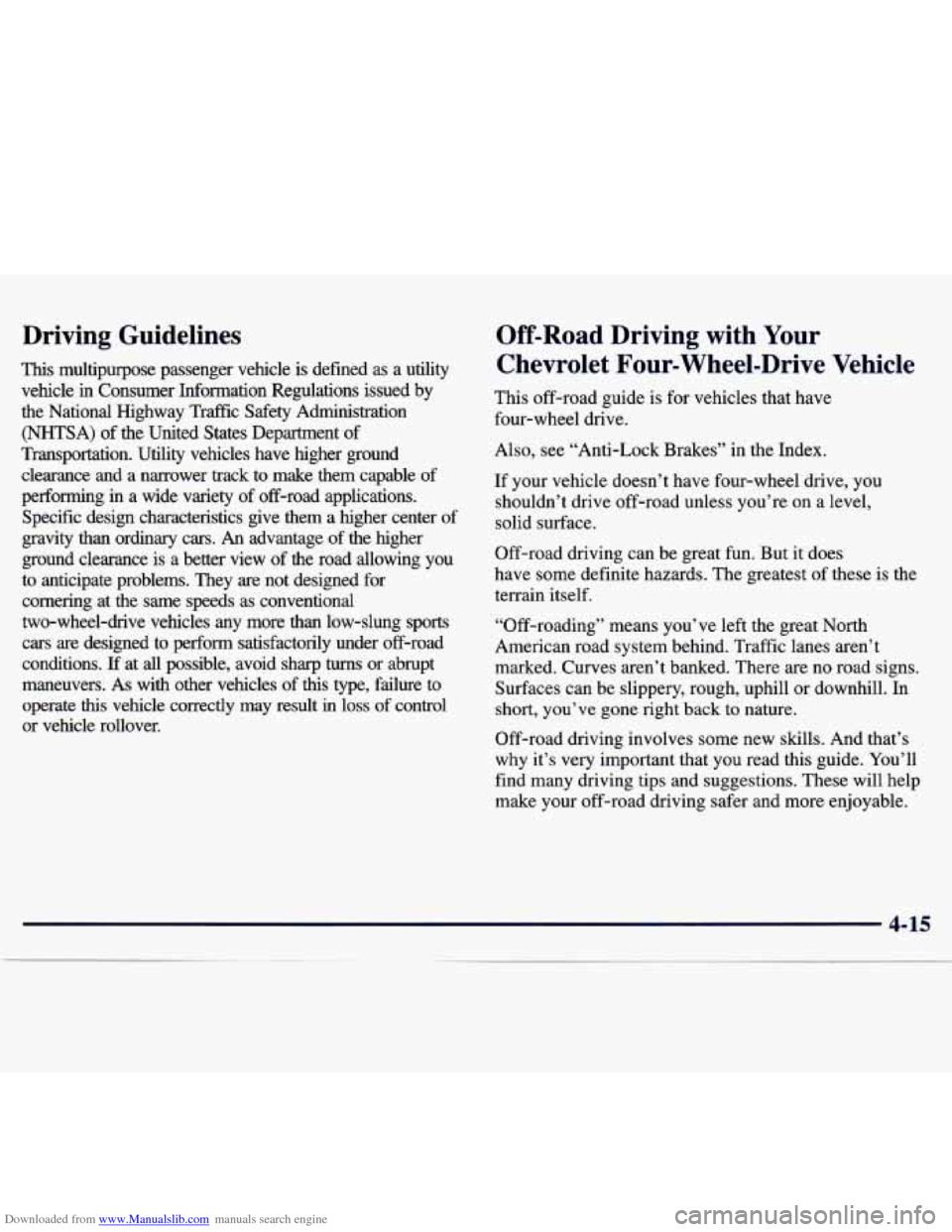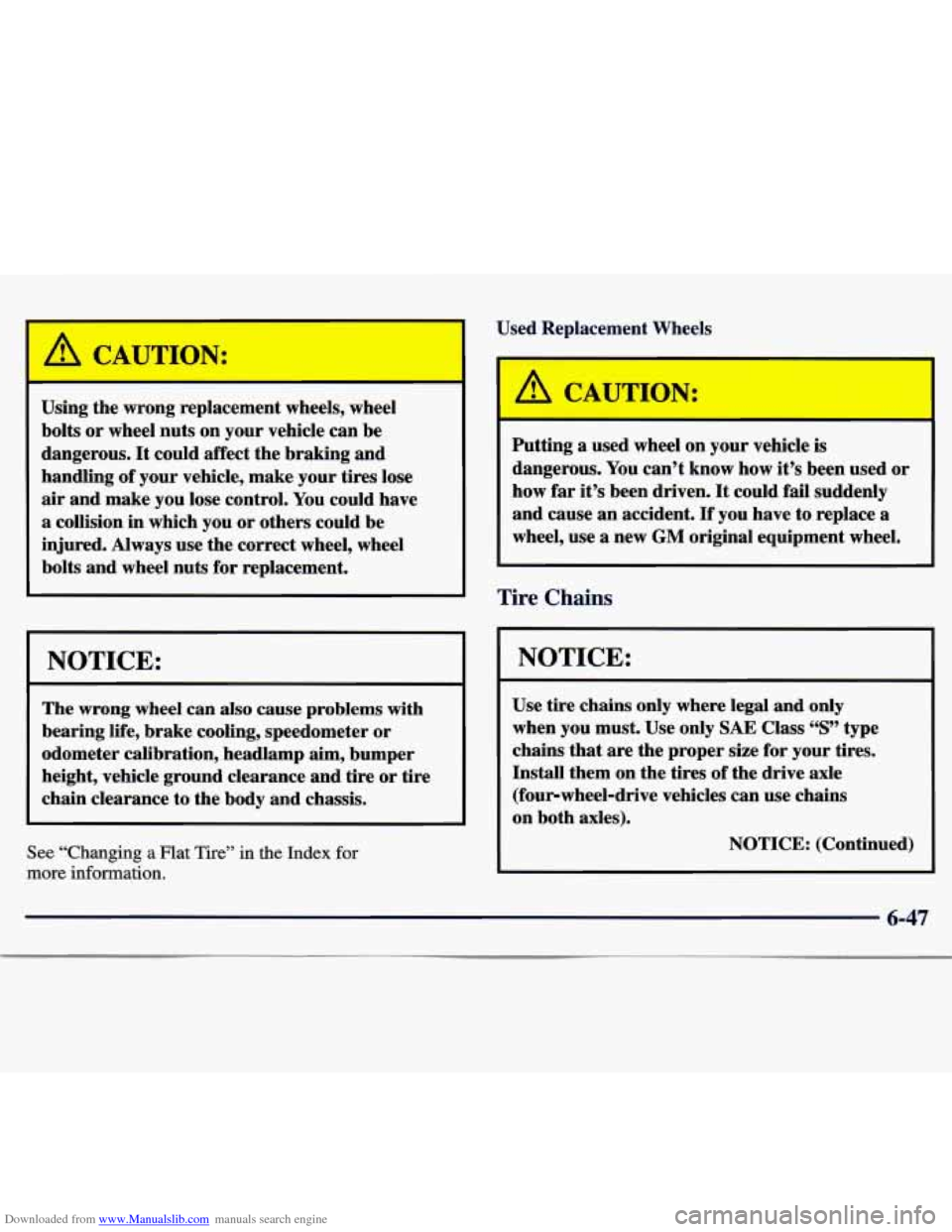ground clearance CHEVROLET TRACKER 1998 1.G Owners Manual
[x] Cancel search | Manufacturer: CHEVROLET, Model Year: 1998, Model line: TRACKER, Model: CHEVROLET TRACKER 1998 1.GPages: 386, PDF Size: 21.17 MB
Page 160 of 386

Downloaded from www.Manualslib.com manuals search engine Driving Guidelines
This multipurpose passenger vehicle is defined as a utility
vehicle
in Consumer Information Regulations issued by
the National Highway Traffic Safety Administration (NHTSA) of the United States Department of
Transportation. Utility vehicles have higher ground
clearance and a narrower track to make them capable of
performing in a wide variety of off-road applications.
Specific design characteristics
give them a higher center of
gravity than ordinary cars.
An advantage of the higher
ground clearance is a better view of the road allowing you
to anticipate problems. They are not designed for
cornering at the same speeds as conventional two-wheel-drive vehicles any more than low-slung sports
cars are designed to perform satisfactorily under off-road
conditions.
If at all possible, avoid sharp turns or abrupt
maneuvers. As with other vehicles of
this type, failure to
operate
this vehicle correctly may result in loss of control
or vehicle rollover.
Off-Road Driving with Your
Chevrolet Four-Wheel-Drive Vehicle
This off-road guide is for vehicles that have
four-wheel drive.
Also, see “Anti-Lock Brakes” in the Index.
If your vehicle doesn’t have four-wheel drive, you shouldn’t drive off-road unless you’re on
a level,
solid surface.
Off-road driving can be great fun. But it does
have some definite hazards. The greatest of these is the
terrain itself.
“Off-roading” means you’ve left the great North
American road system behind. Traffic lanes aren’t
marked. Curves aren’t banked. There are
no road signs.
Surfaces can be slippery, rough, uphill or downhill. In
short, you’ve
gone right back to nature.
Off-road driving involves some
new skills. And that’s
why it’s
very important that you read this guide. You’ll
find many driving tips and suggestions. These will help make your off-road driving safer and more enjoyable.
Page 284 of 386

Downloaded from www.Manualslib.com manuals search engine ,A CAUTION:
Using the wrong replacement wheels, wheel
bolts or wheel nuts on your vehicle can be
dangerous. It could affect the braking and
handling of your vehicle, make your tires lose
air and make you lose control. You could have
a collision in which you or others could be
injured. Always use the correct wheel, wheel
bolts and wheel nuts for replacement.
NOTICE:
The wrong wheel can also cause problems with
bearing
life, brake cooling, speedometer or
odometer calibration, headlamp aim, bumper
height, vehicle ground clearance and
tire or tire
chain clearance to the body and chassis.
See “Changing a Flat Tire” in the Index for
more information.
Used Replacement Wheels
L A CAUTION:
Putting a used wheel on your vehicle is
dangerous. You can’t know how it’s been used
or
how far it’s been driven. It could fail suddenly
and cause an accident.
If you have to replace a
wheel, use a new GM original equipment wheel.
Tire Chains
NOTICE:
Use tire chains only where legal and only
when you must. Use only SAE Class “S” type
chains that are the proper size for your tires.
Install them on the tires of the drive axle
(four-wheel-drive vehicles can use chains
on both axles).
NOTICE: (Continued)
6-47